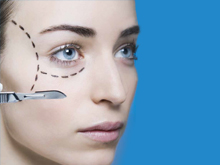 |
Your skin is like your visiting card - when you meet someone for the first time, the impression that’s registered is their skin. Your skin is also the representative of your overall health status. Let us discuss about perfect skin and more importantly, see how we can have it. |
What is Good Skin?
Universally, good skin refers to uniform appearance of any complexion, with good lustre and no pimples, marks, scars, wrinkles, etc. In India, fair skin is considered as beautiful skin - which is not true if viewed with international perception. Whatever the skin complexion, it should be with a good quality skin, along with proper hair and nails. To have these, one should have the knowledge of taking care of them, right from childhood until old age.
Taking Care
During childhood, the ability to repair the skin is faster, due to abundant amounts of collagen in it, but the same won’t happen after a certain age due to reduction in collagen. At this point, people get worried and try various means to look better.
- Home care has been around since ages. You would have heard that Cleopatra used to bathe in the milk tubs. Or remember your granny suggesting some milk /cream/curd/ turmeric powder/coconut oil, etc. for your skin.
- Parlour care has started a few decades back – a place where you get a facial, threading, waxing, bleaching, manicure and pedicure, electrolysis, etc.
- There’s also something called medical skin care, which we are going to explore in this article. We will look at infant, childhood and adolescent skin care in this issue.
Instructions for Infants & Children
- Use less soap.
- Don’t use cosmetics.
- Get adequate moisturising by creams and baby oils after the bath.
- Talcum powder should be used only in the skin folds.
- Take care of diaper rash with calamine and frequent change of diaper, along with toilet training as soon as possible.
- Clothing should be selected as per weather conditions, and they should be soft and friendly to the skin.
- Children with dry skin, who have family history of allergic conditions, are susceptible to a condition called atopic dermatitis, due to which white patches are seen on the face. This may cause skin to be sensitive to light, as they grow older.
During Adolescence
Ah, those pimple years! Nowadays, topical creams to oral medication are available for these. But don’t prescribe these for yourself – remember that your face is your visiting card. Do consult your dermatologist.
- For initial Grade I & II acne, applying Benzyle Peroxide, Clindamycin, Erythmycin, Azithromycin or Retinoids in topical form should do the trick.
- Grade III acnes are treated with oral antibiotics and topical creams.
- Grade IV ones would need oral tetinoids.
- Recurrent acne can be tacked with chemical peels like Salisylic acid, Retinoic acid, Glycolic acid and combination peels, lasers, UV lights, etc.
- Scarring following acne is difficult to treat completely, but partial improvement can be achieved with fraxel, dual pulsed ND Yag and IPL lasers (no, not the cricketing variety). Techniques like microdermabrasion, dermarollers and fillers are also helpful.
- Adolescence is about a lot of energy – some being channelised through outdoor sports, and screeching about on two-wheelers. But since that exposes you to the sun, pigmented lesions can appear on various parts of the body. Their reversibility is reasonably acceptable during adolescence, but in teens with more photosensitive skin, more prone for higher pigmentation, this might lead to permanent dark pigmented skin.
- Blackheads and white heads can be treated with regular skin exfoliation procedures. Creams can be used to reduce the oily secretions of the skin.
- Tight and pointed footwear could be fancy wear for a party, but they will damage your feet, young lady. Don’t snigger, boy – so do improper fitting sports shoes! These could damage your nails, leading to nail-bed infection (paronychia) and ingrown, curved and crooked toenails. Did you consider that your footwear could thus make you require surgical intervention?
- Add to this, nail fungus infection, characterised by hard, brittle & lustreless nails. If not tackled early, there is a chance of the infection spreading to other nails. This has to be tackled with oral and topical antifungal medicine – though at times they require surgical nail removal.
- And be careful at your beauty parlour – excessive or premature pedicuring and manicuring can leave wounds on your nail-bed, apart from causing nail infections.
|
Dr. Sailaja Surpaneni is Consultant Dermatology and Cosmetic Surgery
|
|